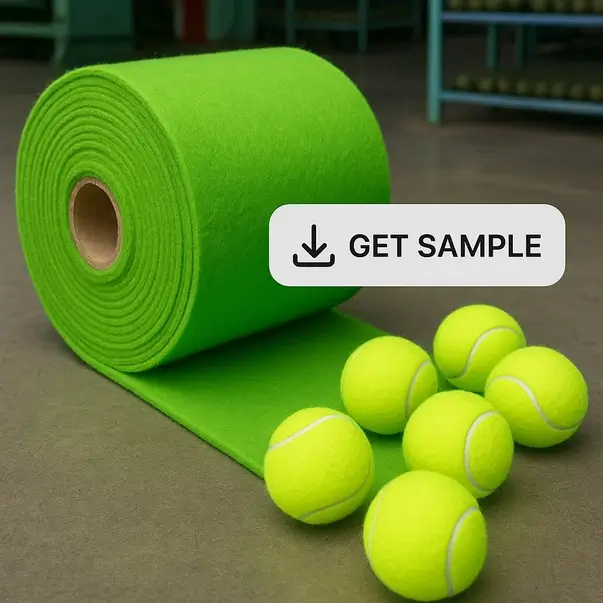Ever grabbed a tennis ball and wondered, “What is this fuzzy stuff?” Or perhaps you’ve searched online, curious about the core hidden beneath that signature yellow cover? You’re not alone! Questions like “tennis ball material,” “tennis ball felt fabric,” and “what are tennis balls made of” are incredibly common. Let’s unravel the science and engineering behind this essential piece of sports equipment.
Beyond Just Rubber and Fuzz: A Layered Approach
A modern tennis ball is a marvel of simple yet effective design, primarily consisting of two key components working in harmony:
- The Core: The Powerhouse (Usually Rubber)
- Material: The core is predominantly made from rubber. This isn’t just any rubber, though. It’s a precisely formulated compound, often a blend of natural rubber and synthetic rubber (like butyl or halogenated butyl rubber).
- Function: The rubber core is responsible for the ball’s bounce and durability. Its elasticity determines how high the ball rebounds off the court and the racquet strings.
- Pressure Matters: Most traditional tennis balls are pressurized.
- Pressurized Cores: These have hollow centers filled with air or nitrogen gas under pressure (typically around 12-14 psi above atmospheric pressure). This pressurized gas is trapped inside the solid rubber shell, creating the lively bounce we expect. Over time, gas slowly permeates through the rubber, causing the ball to go “dead” (lose bounce).
- Pressureless Cores: These feature a solid core made from a heavier, denser rubber compound designed to bounce through the material’s inherent properties, not internal gas pressure. They wear down on the outside first but maintain bounce longer overall. They often feel heavier initially.
- The Cover: The Grip & Control (The Felt)
- Material: This is the iconic fuzzy layer! It’s commonly referred to as felt, but technically, it’s a needle punched non-woven fabric. The standard material is Melton wool.
- Composition: High-quality tennis ball felt isn’t pure wool. It’s typically a blend:
- Wool (Often 70-80%): Provides excellent durability, resilience, and crucial moisture-wicking properties. Wool fibers naturally curl and interlock, creating the fuzzy nap essential for grip on court surfaces and strings.
- Nylon (Often 20-30%): Added for increased strength, abrasion resistance, and to help maintain the felt’s structure during intense play. The exact wool/nylon ratio can vary slightly by manufacturer and ball type (e.g., extra duty felt for hard courts has more nylon).
- Function: The felt is absolutely critical for:
- Grip & Spin: The fuzzy nap grips the court surface during the bounce and grips the racquet strings, allowing players to generate topspin, slice, and control.
- Durability: Protects the rubber core from abrasion against the court.
- Aerodynamics: Influences how the ball travels through the air.
- Moisture Management: Wool naturally wicks away light moisture (like dew) better than pure synthetics.
- The Manufacturing Magic: The felt fabric is cut into a specific dumbbell or “dog bone” shape. Two pieces are precisely aligned and bonded (using adhesive and heat) around the rubber core. The seam where they join is the characteristic ridge you feel on a new ball. The final step involves steaming the balls in a finishing drum to raise and soften the nap, creating the uniform fuzzy surface.
Why These Specific Materials?
The combination of a pressurized (or specially formulated pressureless) rubber core and a wool/nylon felt cover isn’t arbitrary. It’s the result of decades of evolution to meet specific performance requirements dictated by the International Tennis Federation (ITF):
- Controlled Bounce: The rubber core provides consistent, predictable rebound.
- Optimal Speed & Feel: The weight and core pressure affect how the ball comes off the racquet.
- Durability for Intense Play: The felt blend withstands the abrasion of hard courts, clay, and grass, while the rubber core resists cracking.
- Consistent Grip & Spin Generation: The wool/nylon felt’s texture is paramount for modern stroke mechanics.
- Visibility: The bright yellow (or white) dye adheres well to the wool/nylon blend.
Beyond the Basics: Variations & Regulations
- Court-Specific Felt: “Extra Duty” felt, designed for hard courts, often has a slightly higher nylon content for increased durability against abrasive surfaces. “Regular Duty” felt, often used on clay or indoor courts, may have a slightly higher wool content, offering a bit more feel but potentially wearing faster on hard surfaces.
- ITF Approval: All official tennis balls must meet strict ITF regulations regarding size, weight, bounce, and deformation. The materials used are central to passing these tests. Approved balls are stamped with the ITF logo.
- Color: While optic yellow is standard for maximum visibility, white balls are still used occasionally, especially in senior competitions or specific historic events.
Summary: What Tennis Balls Are Made Of
| Component | Primary Material(s) | Key Function(s) | Important Notes |
|---|---|---|---|
| Core | Rubber Compound (Natural + Synthetic like butyl) | Provides bounce & durability | Pressurized cores have internal gas; Pressureless cores are solid denser rubber |
| Cover (Felt) | Non-woven Fabric Blend (Melton Wool + Nylon) | Provides grip, spin generation, durability, moisture wicking | Wool (70-80%) for feel/moisture; Nylon (20-30%) for strength. Key for performance! |
Conclusion: More Than Meets the Eye (Or Hand!)
The next time you pick up a tennis ball, you’ll appreciate the sophisticated simplicity of its construction. That bright yellow sphere is the result of carefully engineered materials – a resilient rubber core for bounce and a precisely blended wool/nylon felt for grip, spin, and durability. Understanding the “tennis ball felt material” and the core beneath demystifies why a fresh can of balls feels and plays so distinctly, and why that iconic fuzzy texture is absolutely fundamental to the game itself. Whether you’re a casual player or a dedicated competitor, the humble tennis ball’s material science is a key part of the on-court experience.

